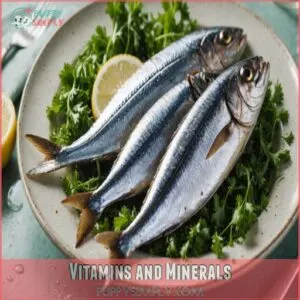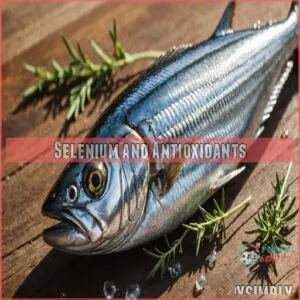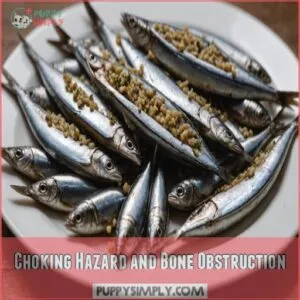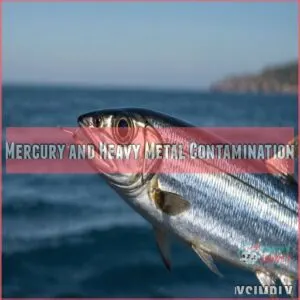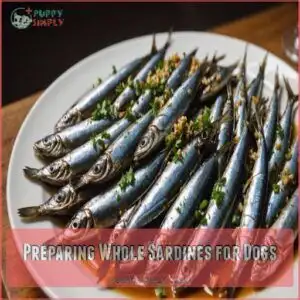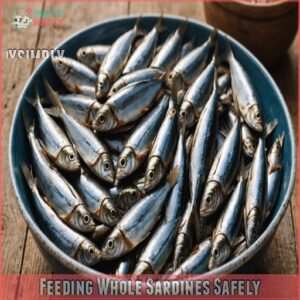This site is supported by our readers. We may earn a commission, at no cost to you, if you purchase through links.
 Yes, dogs can eat whole sardines, and they’ll likely wag their tails in approval!
Yes, dogs can eat whole sardines, and they’ll likely wag their tails in approval!
Sardines are a fishy jackpot, full of omega-3 fatty acids, high-quality protein, and essential vitamins—perfect for a shiny coat and healthy joints.
Just remember, moderation is key to avoid digestive issues or too much mercury exposure.
Opt for sardines in water, not oil or sauce.
And if you’re worried about bones, they’re usually soft enough to eat, but a quick check doesn’t hurt.
Want to make sure their diet swims smoothly? Stay tuned as we tackle the do’s and don’ts of feeding your furry friend these tasty treats!
Table Of Contents
- Key Takeaways
- Nutritional Value of Whole Sardines
- Risks of Feeding Whole Sardines
- Can Dogs Eat Whole Sardines?
- Preparing Whole Sardines for Dogs
- Alternatives to Whole Sardines for Dogs
- Feeding Whole Sardines Safely
- Consultation and Precautions
- Frequently Asked Questions (FAQs)
- Can dogs eat sardine fish?
- Can I give my Dog sardines every day?
- Can sardines make a dog sick?
- Can dogs eat sardine bones?
- Are There Any Risks to Feeding Your Dog Sardines?
- Can Dogs Eat Canned Sardines?
- What Other Canned Fish For Dogs Should I Consider?
- How Should I Go About Feeding Dogs Sardines?
- How Often Should I Feed Sardines to My Dog?
- Can dogs eat whole sardines with bones?
- How much sardines can a dog eat?
- Is it safe to eat whole sardines?
- Can dogs eat sardines with bones on Reddit?
- Are sardine bones harmful to dogs?
- Whole sardines: safe for small breeds?
- Can I feed my dog raw sardines?
- Best way to store whole sardines?
- Sardines and dog allergies: any concerns?
- Conclusion
Key Takeaways
- Dogs can eat whole sardines, which are packed with omega-3 fatty acids and high-quality protein that support a shiny coat and joint health.
- Always serve sardines in moderation to avoid digestive issues and the risk of mercury buildup. Stick to once or twice a week.
- Opt for sardines packed in water, not oil or sauce, and check for soft bones to prevent choking hazards.
- Consult your vet before introducing sardines to ensure they suit your dog’s dietary needs and health conditions.
Nutritional Value of Whole Sardines
In terms of nourishing your dog, whole sardines pack a punch with omega-3 fatty acids, high-quality protein, and a medley of essential vitamins and minerals.
These tiny fish offer selenium and antioxidants, contributing greatly to your dog’s overall well-being.
Whole sardines put a gleam in their coat and a bounce in their step.
Rich in Omega-3 Fatty Acids
Omega-3 benefits are a game-changer for your dog’s health.
These fatty acids, abundant in sardines, are rich in omega-3s, which when combined with other omega-3 rich foods, work wonders on your dog’s coat and skin, making them shine like a superhero cape.
They also support joint health, keeping your dog nimble as a gymnast, and promote heart health, like a good cardio workout.
Sardines can be a tasty, beneficial treat!
High-Quality Protein Content
You’ll find sardines are packed with high-quality protein, a key part of your dog’s diet.
This lean protein is fantastic for muscle growth and overall health.
Think of it as a superfood for strong muscles!
Sardines offer a great protein source, supporting your pup’s energy levels and keeping them active.
Remember, though, moderation is key in dog nutrition.
Vitamins and Minerals
Just like protein amps up your dog’s muscle game, sardines are packed with vitamins and minerals that boost their overall health.
Vitamin D helps bone strength, while vitamin B12 fuels energy levels.
It’s like giving your pup a first-class ticket to wellness.
Plus, sardines meet calcium needs, adding a splash of zest to their diet.
Selenium and Antioxidants
While sardines provide a vitamin boost, they also pack a punch with selenium and antioxidants, safeguarding your dog’s immune system.
These nutrients are like tiny superheroes fighting free radicals to prevent cell damage.
Remember:
- Check sardines for bones.
- Serve them in moderation.
- Ditch any with added oils or salts.
It’s like giving your pup a daily security detail!
Risks of Feeding Whole Sardines
When feeding your dog whole sardines, you might be providing more than just a tasty treat—they can come with hidden risks.
From tiny bones that could cause choking to the lurking potential of mercury contamination, you should carefully consider these factors before making sardines a regular part of your dog’s diet.
Choking Hazard and Bone Obstruction
Sardines’ tiny bones might seem harmless, but they can pose a sneaky risk for your dog’s throat.
Deboning techniques become your best friend here.
Even though the bones are often small and soft, ensuring safe swallowing is key.
Focus on the bones’ size and softness to minimize risk factors and keep meal times worry-free for both you and your pup.
Mercury and Heavy Metal Contamination
Beware of mercury levels when feeding sardines to your dog.
Heavy metals lurking in fish can pose dietary risks over time.
Keep it simple: stick to smaller, younger fish with lower contamination chances.
Trustworthy sources and solid heavy metal testing are your friends.
Consider safe alternatives if you’re worried; your pup’s health is worth a little extra effort.
Overfeeding and Digestive Issues
Eating too many sardines can upset your dog’s stomach, resulting in gas, diarrhea, or even vomiting.
Signs of overfeeding include noticeable stomach upset and lethargy.
Remember, moderation is key.
To keep your pup’s tail wagging happily, limit sardine treats to once or twice a week.
Like with your favorite dessert, a little indulgence is plenty without overdoing it.
Can Dogs Eat Whole Sardines?

So, you’re wondering if your furry friend can enjoy a whole sardine? While sardines offer some nutritional benefits, it’s important to understand the potential risks before sharing this fishy treat.
Benefits for Skin and Coat Health
Giving your dog sardines can lead to a shiny coat and healthy skin. The omega-3 benefits include:
- Reduced Shedding: Less fur around your home.
- Softer Fur: A plush touch to your dog’s coat.
- Moisturized Skin: Minimizes itchiness and dryness.
- Fish Oil Alternatives: Easier than supplements, making it simple to keep your dog’s fur healthy.
For maintaining healthy skin and a lustrous coat, consider exploring dog coat health products here to support coat health.
Joint Health and Mobility Benefits
Feeding your dog whole sardines can be a great source of fatty fish like salmon. Sardines can be a game-changer for your dog’s joint health.
Packed with omega-3s, they help reduce inflammation, making them perfect for dogs with arthritis or hip dysplasia.
In fact, incorporating canned sardines benefits can contribute to improved skin and coat health, ocular development, and cardiovascular well-being.
Think of omega-3s as tiny mechanics working tirelessly to keep those joints running smoothly.
Adding sardines to your pup’s diet might just be the arthritis support for a more playful life.
Support for Heart Health
In terms of heart health benefits, sardines can play a key role in your dog’s diet.
Thanks to their omega-3 content, these tiny fish help keep dog heart disease at bay by supporting healthy blood flow and reducing inflammation.
While sardines vs. supplements may spark debate, incorporating them into your pup’s meals is a tasty way to boost cardiac wellness.
Preparing Whole Sardines for Dogs
When preparing whole sardines for your dog, start by removing the bones to avoid any choking hazards.
Cook them using methods like boiling or baking, and steer clear of any additives or preservatives to keep your dog’s meal healthy.
Deboning and Removing Bones
Cooked, unseasoned fish like sardines, a good source of omega-3 fatty acids for dogs, requires safe bone removal when handling sardines for your dog’s meal.
Knowing fish anatomy, use deboning tools to tackle even small bones—tiny yet potentially troublesome!
It’s like a treasure hunt, only this time, you’re seeking to eliminate risks.
Engage your inner chef by ensuring thorough bone removal, transforming these omega-3 wonders into a safe, delicious treat for your furry friend.
Cooking Methods for Whole Sardines
You’ve got those sardines all prepped, now what’s next?
Cooking them right boosts the yum without losing nutrients.
Try these methods:
- Boiling: Keeps ’em juicy, easy on digestion.
- Baking: Locks in flavors; just watch that temp!
- Grilling: Adds smoky goodness, but don’t char.
- Steaming: Gentle on nutrients, just the way dogs love it.
Avoiding Additives and Preservatives
Choosing sardines? Reading labels carefully is key!
Avoid canned sardines packed in oil or with extra salt – those aren’t your dog’s best friends.
Opt for organic sardines packed in water for a healthier, natural alternative.
Consider adding them as a treat to your dog’s diet after introducing cooked fish skins safely.
Fresh sardines are even better, but make sure you cook them thoroughly.
Homemade dog treats using sardines? Always check the ingredients!
Alternatives to Whole Sardines for Dogs
If whole sardines aren’t the best fit for your dog, don’t worry—there are plenty of other options to keep their tails wagging.
Consider salmon or tuna for essential omega-3s or opt for fish oil supplements, and remember, your vet can help guide your choices.
Other Fish Options for Omega-3 Fatty Acids
When considering fish options for your dog, remember that safe fish options like low-mercury fish options are essential to avoid mercury poisoning and other health risks. When considering fish options beyond sardines for your dog’s omega-3 boost, think about including salmon, tuna, mackerel, herring, and anchovies.
Each one is packed with healthy fats that support a shiny coat and joint health.
Just remember, moderation is key!
These fish offer great nutritional benefits without piling on the calories, keeping your dog both happy and healthy.
Supplements for Omega-3 Fatty Acids
So your dog’s not wild about fish? Omega-3 supplements can be your ace in the hole. Here’s the scoop:
- Fish oil vs flaxseed: Fish oil tops the charts for dogs, but flaxseed works too.
- Dosage guidelines: Always check with your vet first.
- Side effects: Itching or diarrhea? Reduce the dose and watch for changes.
High-Quality Dog Food Alternatives
Exploring alternatives for whole sardines? Consider these options in high-quality dog foods: You can also find balanced nutrients in top-rated brands listed under top best dog food brands online(best dog food brands).
| Option | Description |
|---|---|
| Homemade | Custom meals offer control over ingredients. |
| Raw Diets | Mimics natural prey, but handle with care. |
| Kibble Brands | Provides balanced nutrients in dry form. |
Choosing wisely allows you to meet nutritional needs without fishy business. Just make sure the new diet is suitable for your pup.
Feeding Whole Sardines Safely
Feeding whole sardines to your dog can be a healthy choice, but it’s important to pay attention to portion sizes to avoid overfeeding.
Sardines can be a healthy treat for your dog, but it’s important to watch for any digestive issues to make sure your furry friend stays happy and healthy.
Portion Size Guidelines
While considering sardine alternatives, nailing down portion size for your dog’s diet is key.
Start by accounting for your dog’s weight and breed.
A little common sense goes a long way here:
- Small dogs: One sardine.
- Medium dogs: Two sardines.
- Large dogs: Three sardines.
- Observe for changes in digestion or behavior.
Adjust based on individual needs!
Frequency of Feeding Whole Sardines
Once you’ve figured out the right amount of sardines for your pup, remember less is more!
Don’t overdo it.
A good rule of thumb? One or two times a week, max.
Think of sardines as a tasty treat, not a main course.
Too many can upset their tummy, so keep it moderate for a happy, healthy dog.
Always check with your vet before changing your dog’s diet.
Monitoring for Digestive Issues
Watching Fido nosh on sardines is delightful until signs of an upset stomach pop up.
Keep a keen eye out for these clues:
- Diarrhea frequency increases.
- Vomiting frequency spikes.
- Gas and bloating make an appearance.
- Changes in stool consistency.
- Odd behavior or discomfort.
Regular observation helps keep your pup’s belly content and your carpet clean!
Consultation and Precautions
Before introducing whole sardines into your dog’s diet, you should also consider other small fish like anchovies, which are a safe and healthy treat for dogs when prepared correctly. It’s also important to consult your veterinarian to address any potential health concerns like pancreatitis or weight gain.
Keeping an eye on your dog’s health will help them benefit from this tasty treat without the surprise of a fishy fiasco.
Consult With Your Veterinarian
Before diving into sardine snacks for Fido, chat with your vet.
They know your dog’s health and can spotlight any sardine allergies or dietary restrictions.
If you suspect your dog has a sardine allergy, check out resources on dog sardine allergy for helpful products.
No two pups are the same, so here’s a quick guide:
| Concern | Considerations |
|---|---|
| Allergies | Check for reactions |
| Breed Specifications | Individual dietary needs |
| Health Conditions | Tailor meals accordingly |
| Age | Nutritional requirements vary |
| Diet Type | Make sure they’ve a balanced intake |
Your vet’s your best ally for happy, healthy feeding!
Precautions for Pancreatitis and Weight Gain
Balancing sardine portions for your dog’s breed helps dodge pancreatitis risks and manage weight, especially when considering a low-fat diet with fat content under 10% of total calories as recommended for dogs with pancreatitis.
If your pooch seems porkier, consider a leash on their sardine splurge.
Sardines can be oily, so adjust their diet to keep them agile.
Think of it as a seafood symphony where too much of a good thing can hit a sour note.
Monitoring Your Dog’s Health
To keep an eye on your dog’s health, think of their body as a dashboard.
Check these gauges regularly:
- Digestive changes: Notice any shifts in stool consistency.
- Weight gain: Is your pup packing on the pounds?
- Energy levels: A sudden plummet might raise eyebrows.
- Skin problems: Look out for unusual itching or rashes.
Just a bit of monitoring can keep tails wagging!
Frequently Asked Questions (FAQs)
Can dogs eat sardine fish?
Yes, dogs can eat sardine fish, providing a healthy boost with protein and omega-3s.
Avoid high mercury levels by limiting intake; choose plain, cooked fish.
Mix sardines occasionally into meals as a tasty, nutritious treat.
Can I give my Dog sardines every day?
Feeding your dog sardines daily isn’t ideal.
While they’re nutritious, too many can cause mercury buildup and digestive issues.
Stick to once or twice a week, and always opt for unsalted ones packed in water.
Can sardines make a dog sick?
Sardines can sometimes upset your dog’s tummy.
While they’re nutritious, the mercury content, small bones, and high oil levels might cause digestive issues or choking hazards.
Moderation and careful preparation help prevent these fishy pitfalls.
Can dogs eat sardine bones?
Sardine bones are small but can still pose a choking hazard or cause digestive issues for dogs.
Make sure they’re thoroughly cooked and carefully deboned before serving.
When in doubt, consult your vet for safety advice.
Are There Any Risks to Feeding Your Dog Sardines?
Watch out for mercury content and choking hazards from bones when feeding sardines to your dog.
Overfeeding can lead to digestive issues, and sardines packed in oil or with additives might be unhealthy.
Always consult your vet first.
Can Dogs Eat Canned Sardines?
Yes, dogs can eat canned sardines, similar to eating canned tuna in moderation as a tuna consumption guideline, but choose those packed in water without added salt or oil.
They’re nutritious, offering protein and omega-3s, but feed them in moderation, like a treat, once or twice weekly.
What Other Canned Fish For Dogs Should I Consider?
Think tuna, salmon, or even shrimp!
Always check for bones and choose options packed in water, not oil.
A vet’s okay is always a good idea before switching up your pup’s diet.
How Should I Go About Feeding Dogs Sardines?
Start with sardines in water, not oil.
Remove bones for safety, cook thoroughly to kill bacteria, and feed them as a treat, not a regular meal.
Always consult your vet for personalized advice, especially with health concerns.
How Often Should I Feed Sardines to My Dog?
Feed your dog sardines once or twice a week to reap health benefits without overdoing it.
They’re like a gourmet treat, but too much could lead to digestive woes.
Balance is key, so don’t go overboard!
Can dogs eat whole sardines with bones?
Dogs can eat whole sardines with bones, but make sure they’re thoroughly cooked and deboned.
Bones can be a choking hazard or cause blockages.
Always choose sardines packed in water, avoiding those in oil or brine.
How much sardines can a dog eat?
Limit sardines to once or twice a week for your dog.
Start small, like a treat, to gauge tolerance.
Too much can lead to mercury buildup or digestive issues, so moderation keeps them healthy and safe.
Is it safe to eat whole sardines?
Ever wonder if munching on whole sardines is safe?
For you, it’s typically fine since sardines offer rich nutrients like omega-3s.
Just make sure they’re cooked thoroughly to dodge any pesky bacteria or parasites that might linger.
Can dogs eat sardines with bones on Reddit?
Yes, dogs can eat sardines with bones, but stick to small amounts and make sure they’re deboned or have soft bones.
Always choose those packed in water without additives.
Consult your vet before adding them to your dog’s diet.
Are sardine bones harmful to dogs?
Don’t worry, you’re not alone in wondering about sardine bones!
Those tiny bones can be a choking hazard or cause digestive upset.
Always remove them before feeding sardines to your pup.
Whole sardines: safe for small breeds?
Whole sardines can be safe for small breeds when they’re deboned and served in moderation.
Avoid canned sardines in oil or with additives.
Introduce them slowly, ensuring they’re cooked properly to reduce potential health risks.
Can I feed my dog raw sardines?
About 10% of dogs can react poorly to raw sardines due to bacteria and parasites.
Cook them instead, and remove bones to prevent choking.
It’s a safer bet and supports your dog’s health without surprises.
Best way to store whole sardines?
Store whole sardines in an airtight container in the fridge to keep them fresh for days.
For longer storage, freeze them individually on a tray before transferring to a freezer bag. This helps maintain freshness and prevents sticking.
Sardines and dog allergies: any concerns?
Dogs can develop allergies to sardines, just like with any protein source.
Look for itching, digestive issues, or ear infections after feeding sardines.
If you spot these signs, consult your vet to rule out allergies.
Conclusion
Ultimately, feeding whole sardines to your dog can be like opening a treasure chest of nutritional benefits.
Can dogs eat whole sardines? Absolutely, but moderation is your best friend to prevent any risks.
These little fish support shiny coats and healthy joints, but always check for soft bones and mercury content.
If you’re ever unsure, chat with your vet to tailor the diet to your dog’s needs.
Enjoy watching your pup enjoy their fishy delight responsibly!



